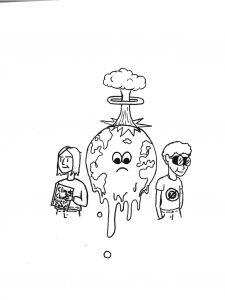According to the National Wildlife Federation (NWF), the 21st century has seen the most temperature records broken in recorded history. Since 2008, over 21.5 million people have been forcibly displaced due to climate change. Global flooding could triple by 2030. More than one million species face potential extinction as a result of disappearing habitats, changing ecosystems and acidifying oceans, as predicted by the NWF. More greenhouse gases are in our atmosphere than any time in human history. Earth could warm by six degrees fahrenheit from current temperatures by the end of this century.
It takes a simple Google search to understand the trajectory of our climate and our planet. As a result of global warming, the human race now faces a 1-in-20 extinction probability by the year 2100, according to The New York Times.

We are currently living in a period of extreme cruciality in altering the course of irreversible climate change. Our generation will determine the possibility of our grandkids inheriting an uninhabitable climate. It is essential that current and future generations of students receive a concrete understanding of their own environmental implications before high school graduation; however, currently only 20 percent of Redwood seniors and juniors are enrolled in AP Environmental Science (APES), Redwood’s only course solely dedicated to environmental science, according to principal David Sondheim.
While there are innumerable ways that our future citizens may decide to respond to environmental challenges, we have an obligation to prepare them in making those decisions. One step in that direction is to provide all high school students with a fundamental understanding of how environmental systems function and how human activities depend upon and impact those systems, which is why environmental science should be a required core curriculum class for high schoolers.
If exploitation of natural resources continues at its current pace, the current generation of school age children will experience unparalleled degradation of the natural environment and loss of biodiversity. Although Earth is predicted to warm by six degrees by the end of this century, any increased warming from current temperatures will bring catastrophic consequences. For example, at four degree warming, the deady European heat wave of 2003—which killed as many as 2,000 people a day—will be a normal summer, according to Intelligencer Magazine.
Students must be educated in order to make environmentally conscious decisions to save the future of the planet, as current misinformation of climate change on a global scale under-stresses the importance of climate-related issues. A 2014 Yale study found that 35 percent of Americans believe that global warming is caused mostly by natural phenomena rather than human activity, and 34 percent think there is much disagreement among scientists about whether global warming is even happening. In reality, 97 percent of scientists agree on the basis of climate change, according to The New York Times.
Data gathered by Horizon Research, Inc. as part of the National Survey in Mathematics and Science Education, show that between 1993 and 2000, the percentage of high schools teaching environmental science increased from 24 percent to 39 percent. Over the last decade, the number of high school students enrolled in the AP Environmental Science course has risen 426 percent nationwide, according to the College Board. However, enrollment in APES at Redwood has only increased 2 percent over the past two years, according to Sondheim.
Students are already taking the initiative to enroll in environmental science classes nationwide; however, not all students are presented with the opportunity to take such a course or hold freedom in their schedule to take an elective science class. Although freshman and sophomore science classes at Redwood include environmental-related curriculum, APES is the only science course that provides students with a fundamental and in-depth understanding of our environment and human impact. Redwood is not alone in this regard; in fact, only one state, North Carolina, requires a year-long Earth/Environmental Science course for high school graduation, according to the State Board of Education.
As a Redwood student, I know the difficulties of “perfecting” my schedule—making room for AP and Honors classes, fulfilling UC A-G requirements, incorporating required curriculum, such as history courses, while simultaneously finding time to blend my interests into my schedule and not overloading my course load. Although I am fortunate enough to take APES as a senior this year, many of my friends have not been afforded the same luxury in schedule availability. As a result, many of my friends will leave Redwood without a fundamental, in-depth understanding of environmental science crucial for tackling future environmental implications.
Incorporating the requirement of environmental science into high school curriculum will provide an opportunity for the entire student body, regardless of schedule complications, to enroll in the class and receive a concrete understanding of our effect on the environment and future environmental deterioration that will be faced without immediate environmental action and policy change.
Incorporating environmental science into graduation requirements might prove difficult at the school or state level; however, The Next Generation Science Standards offers one way of including environmental science into high school curriculum without making the course a required class. Developed by a committee of scientists and education experts, the standards incorporate a variety of scientific practices and concepts for students from kindergarten through 12th grade to master. Through this set of standards, students will enter the real world with a proper understanding of how to alleviate future environmental problems.
Students today stand to inherit a climate severely impacted by global warming and environmental degradation. The ability of future generations to save our planet from climate catastrophe depends on the knowledge of current and future individuals to mitigate environmental problems and create tangible change through environmentally sustainable practices and legislation. One classroom isn’t enough to solve climate change. We must teach our future citizens about solving climate change before time runs out.


















